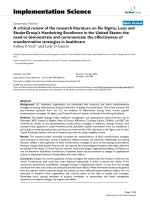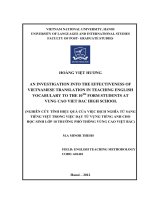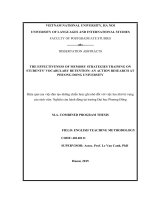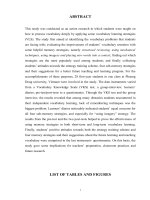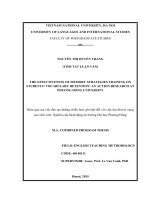THE EFFECTIVENESS OF MEMORY STRATEGIES TRAINING ON STUDENTS VOCABULARY RETENTION AN ACTION RESEARCH AT PHUONG DONG UNIVERSITY
Bạn đang xem bản rút gọn của tài liệu. Xem và tải ngay bản đầy đủ của tài liệu tại đây (383.02 KB, 17 trang )
VIETNAM NATIONAL UNIVERSITY, HA NOI
UNIVERSITY OF LANGUAGES AND INTERNATIONAL STUDIES
FACULTY OF POSTGRADUATE STUDIES
o0o
DISSERTATION ABSTRACTS
THE EFFECTIVENESS OF MEMORY STRATEGIES TRAINING ON
STUDENTS’ VOCABULARY RETENTION: AN ACTION RESEARCH AT
PHUONG DONG UNIVERSITY
Hiệu quả của việc đào tạo những chiến lược ghi nhớ đối với việc lưu nhớ từ vựng
của sinh viên: Nghiên cứu hành động tại trường Đại học Phương Đông
M.A. COMBINED PROGRAM THESIS
FIELD: ENGLISH TEACHING METHODOLOGY
CODE: 60140111
SUPERVISOR: Assoc. Prof. Le Van Canh, PhD
Hanoi, 2015
PART A: INTRODUCTION
This chapter presents the statement of the problem, rationale as well as aims and objectives
of the study reported in this thesis. It also presents the research questions and the scope of
the research. Finally, the chapter ends with an outline of structure of the thesis.
1. Statement of the problem and rationale for the study
Vocabulary is considered an essential part of language learning. According to Knight (1994,
cited in Gu, 2003), learning words is the most important aspect of language acquisition.
Learning vocabulary is regarded as the basis of obtaining other skills. Vocabulary
deficiency can result in weakness in reading comprehension, listening comprehension,
speaking competence, writing performance and grammatical accuracy. Therefore, learning
vocabulary is an indispensable step of L2 acquisition. However, how recently learners have
learnt something is not important, but in fact, the depth of processing. In other words,
students must be taught on how to process information deeply. This view confirmed the role
of understanding and applying Vocabulary Learning Strategies (VLS) in teaching and
learning vocabulary.
Studying VLS has been an interest for a great deal of psychologists, linguists and language
teachers for a long time. There are numerous studies conducted about VLS, their
effectiveness in learning vocabulary and these researchers almost have attempted to develop
a framework of category of VLS (e.g O’Malley & Chamot 1990, Oxford 1990; Gu &
Johnson 1996, Schmitt 1997, Nation 2001)
Vocabulary retention is one of the prolems of vocabulary learning. Students have not
known how to use memory strategies. Thus the training of memory strategies is esential.
However, there are many memory strategies so each study focuses on a group of Memory
strategies.
2. Aim of the study.
The study aims at finding out the extent to which the training of memory strategies help the
students to retain the learned words better. The training in this study is limited to four
strategies as introduced in Oxford(1990)’s taxonomy. These are structured reviewing, using
mechanical techinques, using imagery and placing new words into a context.
3. Research questions.
In an attempt to achieve the above-presented aim, the study was designed to answer the
three following research questions:
1
1. What are the problems second language learners have with vocabulary retention?
2. Why do they have those problems?
3. To what extent does applying the 4 selected strategies, i.e, structured reviewing, using
mechanical techniques, using imagery and placing new words into a context help to
improve students' vocabulary retention?
4. Scope of the study
This action research is an investigation into the effectiveness of the training of Memory
Strategies on students’ vocabulary retention. However, the training does not cover all the
memory strategies. In an attempt to make this study more managable, the study focuses on
the effectiveness of the training of 4 memory strategies: structured reviewing, using
mechanical techniques, using imagery and placing new words into a context on a group of
students (n=28) who were studying English as a minor in Phuong Dong university
curriculum.
5. The organization of the thesis
The thesis is composed of three parts: Part A, Part B, and Part C. Part A – Introduction -
introduces the rationale, aims and objectives as well research questions of the study. Part B
labelled as Development is composed of two chapters: Chapter 1- Literature review -
introduces the theoretical foundations for the whole study and Chapter 2 – Methodology -
elaborates on the participants, the method used, the instruments, the date collecting and
processing procedure from the tests, questionnaires, interviews and learners’ diaries. Part C
– Conclusion - summarizes all the major points in the study, reveals the limitations of the
study and proposes some suggestions for further research.
2
PART B: DEVELOPMENT
CHAPTER 1: LITERATURE REVIEW
This chapter provides an overview of the literature related to the study: from vocabulary
learning strategies, next, memory strategies and last four sub-memory strategies. Besides,
this review also reveals some critical analysis about the systems of classifying vocabulary
learning strategies as well as the research gap, thus motivating to carry out the study.
1.1. Language learning strategies
1.1.1. Background of language learning strategies
1.1.2. Definition of language learning strategies
1.1.3. The importance of language learning strategies in language learning and teaching.
1.1.4. Classification of learning strategies
1.1.5. Strategies Training
1.1.5.1. Why training?
1.1.5.2. How to train?
1.2. Vocabulary and Vocabulary Learning Strategies
1.2.1. Definition of vocabulary
1.2.2. The importance of vocabulary in second language learning
1.2.3. Factors affecting vocabulary learning and acquisition
1.2.4. Retention and factors affecting vocabulary retention
1.2.4.1. Memory
1.2.4.2. Language exposure
1.2.4.3. Effective Vocabulary learning strategies
1.2.5. Vocabulary learning strategies (VLS)
1.2.6. Classification of VLS
3
1.2.7. Oxford’s taxonomy
1.3. Memory strategies
1.3.1. Definition of memory strategies
1.3.2. Why memory strategies?
1.3.3. Oxford’s classification of Memory Strategies
1.3.3.1. Structured reviewing
1.3.3.2. Using mechanical techniques
1.3.3.3. Using imagery
1.3.3.4. Placing new words into a context
4
CHAPTER 2: METHODOLOGY
The following chapter depicts in detail the methodology of this research paper. It includes
first the background of the study, the size and characteristics of the sample, the materials
used then the implementation of an action research as well as the description of data
collection instruments. Furthermore, an elaborate report on the procedures of data collection
and data analysis is also incorporated.
2.1. The rationale of using Action Research
Action research is initiated and conducted by the teacher with his or her own students in his
or her classroom. The purpose and function of Action Research is to help the teacher to
improve his or her own teaching practices (Nunan, 1992). This study is aimed at solving one
particular problem that the teacher-researcher of the study was encountered with: how to
help her students retain words better. The assumption is that the training of memory
strategies may lead to better word retention. This purpose and nature fit well with how
action research is documented in the literature.
2.2. The background to the study
The study was conducted at Phuong Dong university, situated in Hanoi capital, Vietnam.
For 4 years of studying (8 semesters), students have to take 2 different courses: General
English (GE) from semester 2 to 5 and English for Specific Purpose (ESP) for semester 6.
With GE courses, lecturers aim at providing students with genenal knowledge, essential
grammar, vital range of vocabulary for communicative English. Four sub-courses are
carried out to serve this demand. General English 1 (GE1) makes use of the book “Starting
skills 1” (Unit 1-9). GE2 and GE3 exploit “Starting skills 2” respectively first half and
second half of the book. In GE4, students are studying first 5 units of “Starting skills 3”.
GE1 is designed to help students reach A1-1 level. GE2 is for A1-2 level. Accordingly, after
finishing GE4, students are expected to get A2 level according to CEFR. The class was
chosen for this study was all at beginning level, which means all the students had little
knowledge about English. They all met three times a week (Tuesday, Thursday and
Saturday afternoon from 12.30 p.m to 4.15 p.m) for the lessons.
5
In terms of schedule and objectives of the course, this course was conducted in 45 sessions
(15 weeks). Each session lasted 100 minutes. As the name of the class (GE1), this course
aimed at providing students with a system of grammar points and basic vocabulary for
general communication. The main textbook of the course was “Starting Skills 1”. For each
session, the teacher managed to help students cover one out of four skills or grammar points
or vocabulary part which had been clarified in the schedule (See Appendix 2).
The study room was about 20 square meters for about 30 students with such essential
facilities as tables, desks and a board. All the students were arranged into two rows of desks
facing the teacher with an aisle which allowed the teacher to move backwards and forwards
to give lectures or to be a participant with students’ group activities.
2.3. The research process
A typical action research needs to go from one step to another. As suggested by Ferrance
(2000), an action research cycle will be as follows:
Figure 1: Action Research circle
As can be seen from the above cycle, there are six main steps to conduct an action research.
The first is to identify the research problem. Then, data must be collected through means of
interviews, questionnaires, etc. Next, the data is analyzed to find out the problems. The
fourth step is to design a plan of action so that the research can make a change and study
that change. After the intervention has been carried out, it is the researcher’s task to evaluate
its effects to justify whether the action worked or not. Then, if it had not been effective as
expected, another method should be considered in order to improve the situation. This circle
of action research was adopted for this study. The whole process of carrying out this action
research is described below.
6
2.3.1. Identify the problems
Fifty words included in this first VKS were taken from the book: “Tiếng Anh 12”. It was
assumed that the students had learned all these words before their entry into the university.
Twenty-five minutes was the time the teacher allowed her students to complete this kind of
test.
Following the VKS, a follow-up interview was conducted with all 28 students, who had
participated in the VKS survey. A group interview was chosen instead of individual
interviews because the number of interviewees was relatively great (n=28). Regrading the
format, a semi-structured interview format was chosen so that more in-depth information
about the students’ problems of word retention could be obtained.
2.3.2. Gather data
2.3.2.1. Results from VKS
The results showed that the students seemed to be weak at retaining the words that they
have learned. They could see the words familiar, that they had seen them somewhere before,
but they could not give out the meanings or gave out the meanings indecisively. The semi-
interview was used in the next lesson helped to find out whether what students did in the
test was the same as what they said in the interview. Furthermore, an interview also helped
the teacher to go insight the problems that her students were having when learning
vocabulary.
2.3.2.2. Results from the interview
The interview results showed that the number one reason for students’ weaknesses at
vocabulary retention is lack of memory strategies (100%). The second considerable obstacle
is limited opportunities for using words productively (66.7%). Next come the two causes
with the same score 33%: problems with skills in using dictionaries and misbeliefs about
vocabulary knowledge. The final reason involves insufficient time on vocabulary learning
and teachers’ approaches to vocabulary teaching.
2.3.3. Interprete data
The results from the VKS test revealed the fact that the students seemed to be weak at
retaining the words that they have learned. “What were the reasons for this?” was the
question set for the researcher. It could be the insufficiency in time, input, output,
7
techniques for remembering, and knowledge of a word. These were the problems that the
researcher could collect from the interview. Due to the time for the study, the teacher just
tried her best to help students with the biggest reason: lack of memory strategies. This could
be done by equipping students with strategies to retain vocabulary items.
Among ten, four sub-memory strategies were chosen and applied as techniques in
meaningful practice in class to help improve students’ vocabulary learning, namely:
structured reviewing, using mechanical techniques, using imagery and put the word into its
context.
2.3.4. Act on evidence
2.3.4.1. Participants
The participants of this study were 28 university students studying general English course
that students of non English major at Phuong Dong University. These were the students
who had participated in the questionnaire and interview survey.
2.3.4.2. Materials
All the vocabulary being taught in this course was taken from the book “Starting Skills 1”.
There were nine big topics of vocabulary included in the course, namely: Education, Daily
Life, Work and Business, Science and Nature, the Physical World, Culture and Civilization,
Technology, Art and Literature, Sports and Leisure.
Based on the schedule of the course, teacher was in charge of designing handouts for
students to study: in- class handouts and at-home handouts. In the in-class handouts,
teachers explained and helped students to approach the ways to study the words using four
sub memory strategies in turn. At-home handouts were delivered to students after in- class
handouts as a small practicing part with normal gap-filling, word family exercises and a
self-learning and expanding strategies part. Specially, this self- learning part would be
reported in students’ learning diaries.
2.3.4.3. Training and data collection procedure
8
Figure 2: Data collection procedure
2.3.5.Evaluation
2.3.5.1. Data analysis methods and procedures
The data collected were categorized under the three research questions. To be specific, the
VKS test served to answer the first research question, the semi-structured interview the
second and the learners’ diaries, the test scores addressed the last question.
Regarding to the first question, in the VKS test, the students would mark the given word
from Level 1 to Level 5. The teacher then counted the number of each mark for each
student, expressed the figure as a percentage and illustrated in form of a bar chart.
For the second question, in the interview, the data was collected and generalized into
different groups of reasons. The teacher then calculated and illustrated data in a table. By
this way, the researcher and readers could easily see the outstanding problem that students
encountered when retaining vocabulary.
With reference to the last research question, all the learners’ diaries were collected. There
were totally 9 entries for each students, so 252 for all 28 students. The teacher then checked
each entry and calculated the number of each strategy used in each entry. These figures
were then converted to percentage and illustrated under the format of a pie-chart. Moreover,
the data collected from the extra column in the post-test 1 was also analyzed here to answer
the last question. The researcher would count the number of each four sub-memory
strategies used in the test, describe and compare with the results from the diaries. Next, for
data from tests, all the test scores were first recorded. Mean scores in each test were then
calculated. Both the performances of the total group and each student were then indicated
by comparing mean scores between the pre-test and the two other post-tests. By this way,
the improvement of students’ vocabulary retention in short term and long term could be
revealed.
9
2.3.5.2. Findings and discussion.
Findings from learners’ diaries
Figure 3: Strategies used as reported students’ diaries
As can be seen from the chart, it is surprising that the rate of using all four sub-memory
strategies seemed to be comparatively equal among the students (24% for associating, 28%
for placing the word into a context, 19% for grouping and 29% for using imagery). In each
entry, students tended to make use of all four strategies learned to deal with words. The
chart also revealed that “using imagery” and “placing the word into a context” was the two
strategies which appeared the most in students’ entries (29% and 28%, respectively), which
meant most of the students had a preference for visual learning and linking the word with a
specific situation to retain the word. “structured reviewing” seemed to be least used among
students; however, the number for it was not so small: 19% “using mechanical techinques ”
ranked at the third position for the percentage of 24%.
Results from post-test 1, post-test 2
Figure 7: The whole group’
performance in the pre-test, post-
test 1 and post test 2
10
The above line chart indicates that the whole group still stayed stably at the results gained
from the post-test 1 and post test 2 (slight deviation between two points: post-test 1 and
post-test 2). The improvement was not blown away but kept moving (in spite of slight rate:
about 0.17).
Summary
Through thorough analysis of the collected data, the research has discovered that the biggest
problem that almost students encountered in their independent vocabulary learning was the
lack of memory strategies. The analysis of data from the students’ diaries revealed the fact
that students have mastered at somehow the ways to use sub- strategies taught in their
independent learning and which strategies were the most popularly used among them.
Moreover, through the data collected from the pre-test and two post-tests, the application of
four memory strategies were proved to have positive improvement in both students’
vocabulary short term and long-term retention. Finally, students in general all approved for
using memory strategies in their studying vocabulary, which was a good sign for future
application of these strategies in teaching and learning.
2.3.6. Plan for the next stages.
Recommendations for teachers
To begin with, as stated in the literature review chapter, learning will not occur even if the
teacher has provided all the necessary circumstances but the learner is unwilling to
participate in the process. In Scharle and Szabo’s words (2000, p.4, cited in Ngo,
2009),“success in learning very much depends on learners having a responsible
attitude” – a building block of learner autonomy. It means the best way that teachers can
provide students is not only the words, learning strategies to deal with words but the most
important is “helping them to be autonomous”. The researcher of this study had experienced
herself ineffectiveness in strategy training scheme in former classes when just focusing on
teaching and introducing strategies without motivating and forcing students to study on their
own. Together with a lot of above mentioned things, namely necessary knowledge for
conducting a strategy training scheme, the application of four memory strategies in teaching
and learning four language skills; and suggested activities to introduce the four sub-memory
strategies to students, teachers should also take “learner autonomy” as another factor if they
11
want to conduct successfully strategy training. Students should be helped how to keep their
high motivation in learning and adjust their motivation to suite their learning objectives. In
class, creating a friendly and cozy atmosphere is a good way to motivate students to learn
actively because learners only feel free to ask questions, to contribute their ideas if the
lesson is enjoyable and the teacher welcomes their active role. Also in a motivating
atmosphere, teachers can more easily involve their students in making decisions of
classroom activities, lesson pace. At home, necessary activities and exercises should be
given to students with strict requirements from teachers. Of course, this should be done
seriously at the beginning period when students have just started making familiar with
strategies, at a later time, the quantity of homework can be reduced when they can
controlled their own learning.
Secondly, as we know, teachers’ task of introducing and implementing learner training in
their classrooms is very important, but how to introduce and provide students with strategies
in an effective way is also of great importance. If students were just introduced the
strategies without knowing why, where and when to use it, they would not utilize them as
effectively as expected. The matter here is students should not only be provided with new
methods but a chance to master and reflect them in some way as well. Wenden (1986, cited
in Ngo, 2009) made a distinction between informed training and blind training. “Blind
training is when learners are taught strategies but do not know why these are useful.
Informed training involves explicitly telling learners when they are being taught strategies,
as well as why and when these strategies are used.”
Thirdly, in class, teachers should pay more attention to the students’ levels. Learners who
fail to adopt effective VLS, or who have a poor memory for language items, will probably
be unable to absorb as many items as “good- learners”. Or in other words, the fact that some
good students in the class can learn strategies quickly does not mean that all students are
also capable of learning such strategies in a short time. Therefore, it is advisable for teachers
to go each more step with a bit lower level students.
Fourthly, encouraging student to make use of cooperative learning is also a good way that
teachers can empower their learning; moreover, it is also a powerful approach for learner
autonomy. Its aim is to establish a community of learners in which students are able to
generate questions and discuss ideas freely with the teacher and each other. According to
Johnson (1991, cited in Ngo, 2009), “cooperative learning incorporates five elements:
12
positive interdependence; face-to–face promoting interaction; individual accountability and
personal responsibility; interpersonal and small group skills and group processing.”
Cooperative learning can provide an environment in which students can be engaged in more
interesting activities than just listening, taking notes and translating word for word of a
written text. In this approach, students often engage in teaching roles to help other students
learn and to take responsibility for their own learning. After participating in a cooperative
lesson, students can complete similar tasks better by themselves because their critical and
independent thinking abilities have been enhanced. In this thesis, four diary discussions
were samples of cooperative learning, which really gave a big hand for students in learning
from each other and revise themselves before continuing with other new things.
Finally, in Oxford’s book “Language learning strategies - What every teacher should
know” in 1990, there was a very interesting suggestion: a “successful strategies” handbook.
When introducing and implementing strategies to students, teachers should ask them to start
contributing to a “successful strategies” handbook which contains tips on strategies the
students find most useful, examples of strategies applied to specific kinds of tasks or
materials, comments made during strategy training, selections from learners’ diaries about
strategies, or any other strategy-related information. It is advisable to develop the handbook
throughout the language course, in which students can add to it and use it as a way to share
strategy ideas. Moreover, a loose-leaf notebook will allow easiest access and expansion.
In short, basing on all ideas perceived from students and her own experiences during the
implementation of the study, in this part, the researcher would like to share with other
teachers who share the same interest some interesting and useful recommendations when
applying VLS in teaching and learning. It is believed that the experiences and lessons from
the present study would be a great help for the future researchers to save time and conduct
their research more effectively.
PART C: CONCLUSION
13
As the conclusion of the whole research, this chapter will first review significant research
findings of the study. Afterwards, it will pinpoint some limitations of the study, based on
which suggestions for further studies will be offered.
1. Major findings of the study
Firstly, by using both a VKS test and a semi-structured group interview, the researcher
could go deeply into the problems that students had encountered in their independent
learning vocabulary, namely Lack of time, Lack of skills in using dictionaries, Limited
opportunities for using words productively, Teachers’ approaches to vocabulary teaching,
Lack of memory strategies, Misbeliefs about vocabulary knowledge. Among these, the lack
of memory strategies seemed to take the highest consideration and worry from students.
Secondly, based on the results from the initial step: identifying the problems, the teacher-
researcher conducted a teaching plan, in which she provided her students with four sub-
memory strategies, namely structured reviewing, using mechanical techniques, using
imagery, and placing a new word into a context. These strategies were introduced and
implemented through the activities designed both in the in-class handouts and at –home
requirements. At home, students were required to write down their own diaries about their
own ways they dealt with learning the given words by using four taught strategies. After
being collected and analyzed, the data got from these diaries revealed the interesting and
happy results: All four strategies were given a comparatively equal concern from the
students, among them using imagery was the most popular used by students with the
percentage of 29.4%, placing the word into a context ranked the second using mechanical
techniques stood at the third position and structured reviewing numbered the fourth. The
percentage difference was not so much among all four strategies.
Thirdly, the research proved that applying the four memory strategies in teaching and
learning vocabulary has improved students’ vocabulary retention. Although, there was no
control group to make a comparison; however, the consistent training during the scheme
helped to prove the results from the tests. The improvement that students displayed in the
immediate post-test (post-test 1) showed better storing of material in the short-term and
delayed post-test which was the sign of better retrieval in the long-term retention. The better
performance has not only occurred with the whole group but with almost all members of the
group as well (28/28 for short term retention and 27/28 for long term retention).
14
2. Limitations of the study
There must be a number of limitations discerned in the study due to the time constraints and
the researcher’s limited ability and experience.
Initially, in order to identify the problems from students in their independent learning
vocabulary, the researcher had conducted a group interview. By this way, she could save
time and create a friendly and free atmosphere for students to talk, discuss and share their
own ideas. However, as the certain limitation of a group-interview, there appeared the state
of copying ideas from each other and sometimes lack of control from teacher.
In addition, the biggest limitation from this study can be the deficiency of a control group.
In case of a control group, the results got from the tests would be more persuasive and the
way to deal with data would be easier for the teacher.
Despite the shortcomings mentioned above, the effort of the researcher and the participants
as well as serious work in data collection phases could assure the reliability and validity of
the research.
3. Suggestions for further study
Other researchers who develop interest in the same topic may find the following
recommendations useful for their future works.
Firstly, arranging another control group in the research will be a good idea for researchers if
they do not want to add so many methods to ensure the validity and reliability of the study.
Having a control group will help the researcher feel more relaxing when dealing with data
and the results gained from the tests will be more reliable.
Next, in the first phase of this study, identifying the problems, the researcher discovered
many obstacles that students encountered when learning vocabulary. However, due to the
limitation of time for the study, the researcher just selected the biggest problem Lack of
memory strategies and made a plan to deal with it. Thus, other researchers can entirely start
their studies with other problems such as Lack of time, Lack of skills in using dictionaries,
Limited opportunities for using words productively, Teachers’ approaches to vocabulary
teaching, Misbeliefs about vocabulary knowledge.
Finally, a collaborative action research is a good idea for next studies dealing with this kind
of issue. The cooperation of other teachers as co-researchers may result in deeper
15
investigation and more useful suggestions for the future application of teaching and
learning.
16
